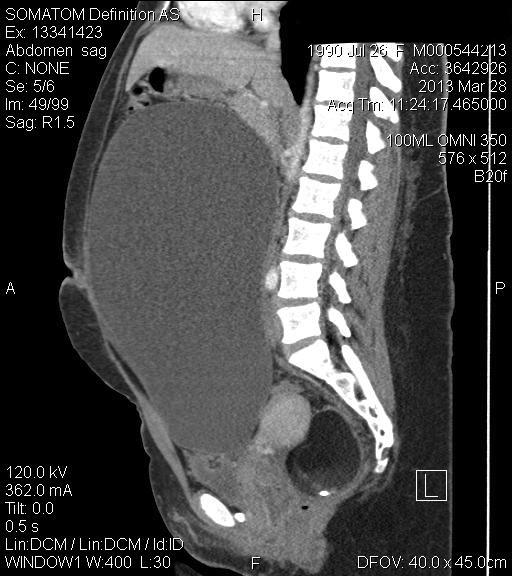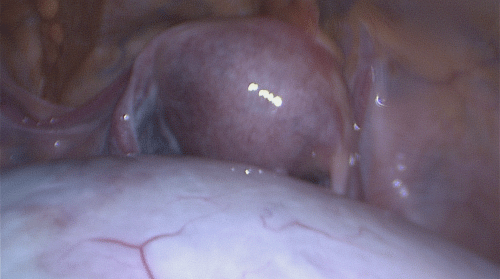Obstetrics and Gynaecology Cases - Reviews
Laparoscopic Management of Bilateral Large Ovarian Cysts in a Young Female
M. Brigid Holloran-Schwartz*, Jacqueline F. Lou and Leslie McCloskey
Department of Obstetrics, Gynecology and Women's Health, St. Louis University, USA
*Corresponding author: Brigid Holloran-Schwartz, M.D., Department of Obstetrics, Gynecology and Women's Health, St. Louis University, 6420 Clayton Road, St. Louis, Mo. 63117, USA, E-mail: holloran@slu.edu
Obstet Gynecol Cases Rev, OGCR-1-008, (Volume 1, Issue 2), Case Report; ISSN: 2377-9004
Received: September 09, 2014 | Accepted: November 12, 2014 | Published: November 15, 2014
Citation: Holloran-Schwartz MB, Lou JF, McCloskey L (2014) Laparoscopic Management of Bilateral Large Ovarian Cysts in a Young Female. Gynecol Cases Rev 1:008. 10.23937/2377-9004/1410008
Copyright: © 2014 Holloran-Schwartz MB, et al. This is an open-access article distributed under the terms of the Creative Commons Attribution License, which permits unrestricted use, distribution, and reproduction in any medium, provided the original author and source are credited.
Introduction
Adnexal masses are a common finding in women of all ages, with a 5-10% lifetime risk of surgery for suspected ovarian neoplasms [1]. The most common symptoms of ovarian cysts are pelvic pressure or pain, however many can remain asymptomatic. Ovarian cancer risk increases in a linear fashion between the ages 30 and 50, with this risk continuing to increase, although at a slower rate, after the age of 50 [1]. While age is the largest risk factor for ovarian cancer, the combined history and physical findings dictate whether an ovarian mass can be expectantly managed with close follow up or surgical management [2]. Laparoscopy has become the standard of care in surgical management of ovarian cysts, and has been increasingly shown to be effective in dealing with even large benign cysts in properly selected patients. It is well established that a laparoscopic approach over a laparotomy has been shown to result in less initial post-operative pain, decreased need for pain medications, shorter hospital stay, quicker return to regular activity and a better cosmetic result. We report the successful management of bilateral large ovarian cysts with ovarian cystectomy and tubal sparing.
Case Report
A 22 year old nulliparous female was evaluated by her new primary care physician for increasing abdominal distention, fatigue, and indigestion over the past 6 months. Over the course of this time, she also began having severe nausea, primarily limited to her menses, only relieved with prescription anti-emetics she had been getting at Urgent Care centers. She had regular cycles, was sexually active with one partner, used condoms and denied dyspareunia, fever or chills. On physical exam, her abdomen was non-tender, but significantly distended with a palpable mass to the level of the xiphoid process. Pregnancy test was negative. Her complete blood count, electrolytes, liver function tests and thyroid panel were normal. Computed tomography scan was done revealing a “massive”, simple, cystic mass extending into the upper abdomen measuring 23x13.3x27cm. In addition, a left ovarian mass with a small calcification, measuring 8x 5x7.3cm was identified, suspicious for a teratoma. Right ovarian tissue could not be definitively identified on computed tomography scan (Figure 1). Pelvic ultrasound was performed in attempt to further characterize the right ovary and potentially the origin of the larger mass but the right ovary could not be identified. The above masses were confirmed on ultrasound. Serum tumor markers were obtained, including a cancer antigen 19-9, cancer antigen 125, and alpha-fetoprotein that were normal. A slightly elevated carcinoembryonic antigen=2.9ng/ml was noted with a normal range of < 2.5ng/ml.

Figure 1: Computed tomography scan of large right ovarian cyst.
View Figure 1
Given the low suspicion for malignancy, a laparoscopic approach was planned in collaboration with a senior gynecologic oncologist. She was consented for a laparoscopic bilateral ovarian cystectomy, possible bilateral oophorectomy, possible bilateral salpingectomy, possible staging procedure, and possible laparotomy. The specific risks of using a laparoscopic approach were discussed with the patient, including the need to drain the larger cyst and possible cyst rupture that could seed tumor cells in the event of malignancy advancing the stage and worsening the prognosis of disease.
Laparoscopic access was obtained using an open approach at the umbilicus. The abdominopelvic cavity was explored and pelvic washings were obtained (Figure 2). The massive cystic structure was indeed coming from the right ovary with the right tube attached and elongated to approximately 10cm. A small portion of the right ovary was seen at the proximal end of the utero-ovarian pedicle adjacent to but distinct from the cystic mass. The right cyst wall was translucent, smooth and benign in appearance. The left ovarian cyst was opaque white and smooth, consistent with a dermoid cyst. Normal left ovarian tissue could be identified. The uterus as well as the remainder of the abdominopelvic cavity appeared normal.

Figure 2: Laparoscopic view of large right ovarian cyst and normal uterus.
View Figure 2
The right ovarian cyst was aspirated with a 18 gauge laparoscopic needle using a 60cc syringe. Once the cyst was decompressed, the right ureter and enlarged ovarian vascular pedicle was visualized. Due to the thick viscosity of the cystic fluid, there was surprisingly very little spillage from the aspiration site. The vascular attachment to the cyst was cauterized and transected. The mesosalpinx was carefully cauterized and transected with an attempt to preserve as much of the vascular supply of the fallopian tube as possible. The entire cyst was excised preserving the small portion of adjacent normal ovarian tissue. There was not a large enough endobag available to accommodate the detached cyst despite 3500mL of fluid drained. The umbilical site skin and fascia were enlarged to 2 cm and an alexis self-retaining retractor inserted with direct removal of the decompressed cyst (Figure 3).

Figure 3: Morcellation of large right ovarian cyst through a 2cm minilaparotomy
using a self retaining retractor.
View Figure 3
The left ovarian dermoid cyst was shelled out intact using an ultrasonic energy device. The cyst was placed in an endobag and morcellated in the bag to decompress prior to removal. The abdominopelvic cavity was copiously irrigated despite minimal spill from the aspirated right ovarian cyst. Ultimately, she retained her fallopian tubes and ovarian tissue bilaterally (Figure 4).The patient's postoperative course was unremarkable. Final pathology revealed a compound lesion in the right ovary consisting of a massive mucinous cystadenoma and a small mature cystic teratoma. The left ovarian cyst was found to be a benign cystic teratoma. She has had resolution of her indigestion, gastro-esophageal reflux and abdominal discomfort.

Figure 4: Post-procedure view of normal uterus and preserved right and left
ovaries and fallopian tubes.
View Figure 4
Discussion
In premenopausal women, the prevalence of ovarian cysts is 8%. The management of such lesions depend on symptoms and the level of concern for malignancy or other complications. The size alone cannot be used to distinguish between benign and malignant masses, however increased size does correlate with increased risk of torsion or rupture [3]. Benign lesions represent 90% of all ovarian tumors and frequently found in a younger age group. The imaging modality of choice in evaluating adnexal masses is transvaginal ultrasound. Favorable ultrasound characteristics include simple cysts, clear fluid with thin, smooth walls, and lack of loculations or thick septations, ascites, or pelvic and omental masses [4]. In our case, the computed tomography, transvaginal ultrasound findings and tumor markers were suggestive of a benign process. The possibility of malignancy had to be considered due to the size of the lesion and the bilateral nature therefore a gynecologic oncologist was present.
There have been increasing case reports of successful laparoscopic management of large ovarian cysts. In a retrospective study of 81 patients with cysts larger than 10 cm and no radiographic signs of malignancy, laparoscopy was found to be feasible and safe, and tumor size did not affect management in properly selected patients [5]. This study included 6 patients with masses from 20-30 cm and 5 patients with masses >30 cm.
In young patients, ovarian sparing is ideal to preserve fertility and hormone production. In one pediatric study of laparoscopic resection of benign ovarian tumors with gonadal preservation, records of twelve children were studied, of which the average age was 11.8 (9-15) years and average mass size of 8.2cm (5-18), with only two patients having bilateral masses. Successful cystectomy with ovarian preservation was accomplished in all cases [6].
When preoperative assessment for malignancy is low, a laparoscopic approach can be utilized and ideally, an endobag can be used for removal of dermoid cysts to avoid spillage of the cystic contents into the peritoneal cavity. Spillage of cyst contents can cause a chemical peritonitis [7]. In addition, the possibility of intraperitoneal spillage or trocar site implantation of malignant cells is always a concern when resecting ovarian masses. However, thorough peritoneal lavage can decrease the chance of developing peritonitis should spillage occur. In conclusion, laparoscopic management of bilateral large cysts with gonadal sparing in a young female is feasible provided preoperative risk assessment for malignancy is low.
References
-
(1994) National Institutes of Health Consensus Development Conference Statement. Ovarian cancer: screening, treatment, and follow-up. Gynecol Oncol 55: S4-14.
-
Ross EK, Kebria M (2013) Incidental ovarian cysts: When to reassure, when to reassess, when to refer. Cleve Clin J Med 80: 503-514.
-
Borgfeldt C, Andolf E (1999) Transvaginal sonographic ovarian findings in a random sample of women 25-40 years old. Ultrasound Obstet Gynecol 13: 345-350.
-
Lev-Toaff AS, Horrow MM, Andreotti RF, Lee SI, DeJesus Allison SO, et al (2009) Expert Panel on Women’s Imaging. ACR Appropriateness Criteria clinically suspected adnexal mass. Reston, VA: American College of Radiology (ACR). [http://www.guideline.gov/content.aspx?id=43882]
-
Lim S, Lee KB, Chon SJ, Park CY (2012) Is tumor size the limiting factor in a laparoscopic management for large ovarian cysts? Arch Gynecol Obstet 286: 1227-1232.
-
Karpelowsky JS, Hei ER, Matthews K (2009) Laparoscopic resection of benign ovarian tumours in children with gonadal preservation. Pediatr Surg Int 25: 251-254.
-
Clément D, Barranger E, Benchimol Y, Uzan S (2003) Chemical peritonitis: a rare complication of an iatrogenic ovarian dermoid cyst rupture. Surg Endosc 17: 658.





